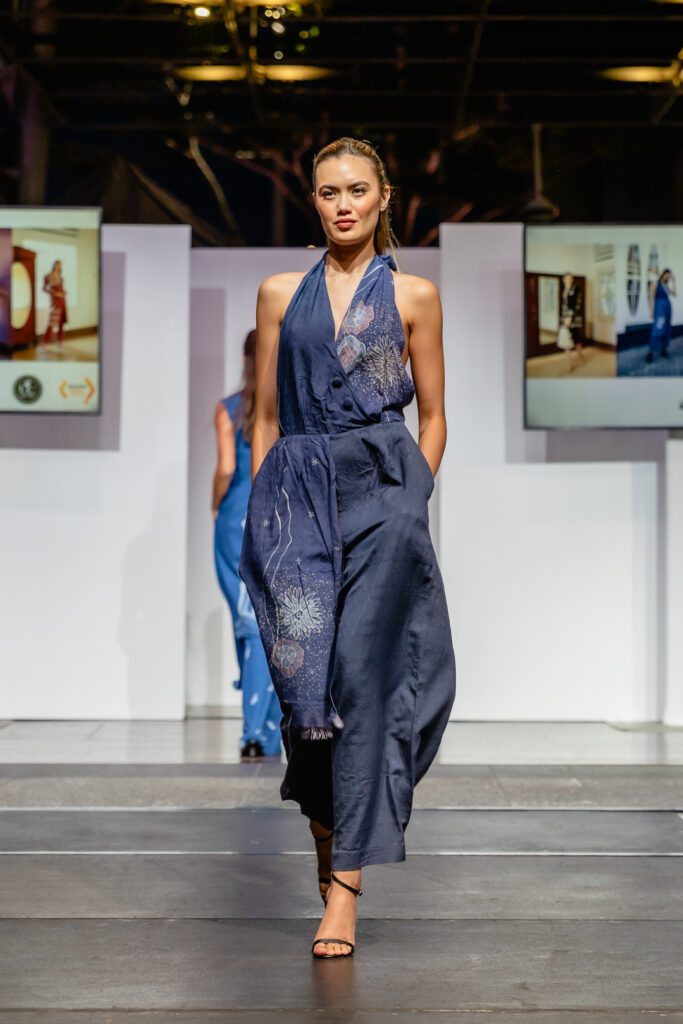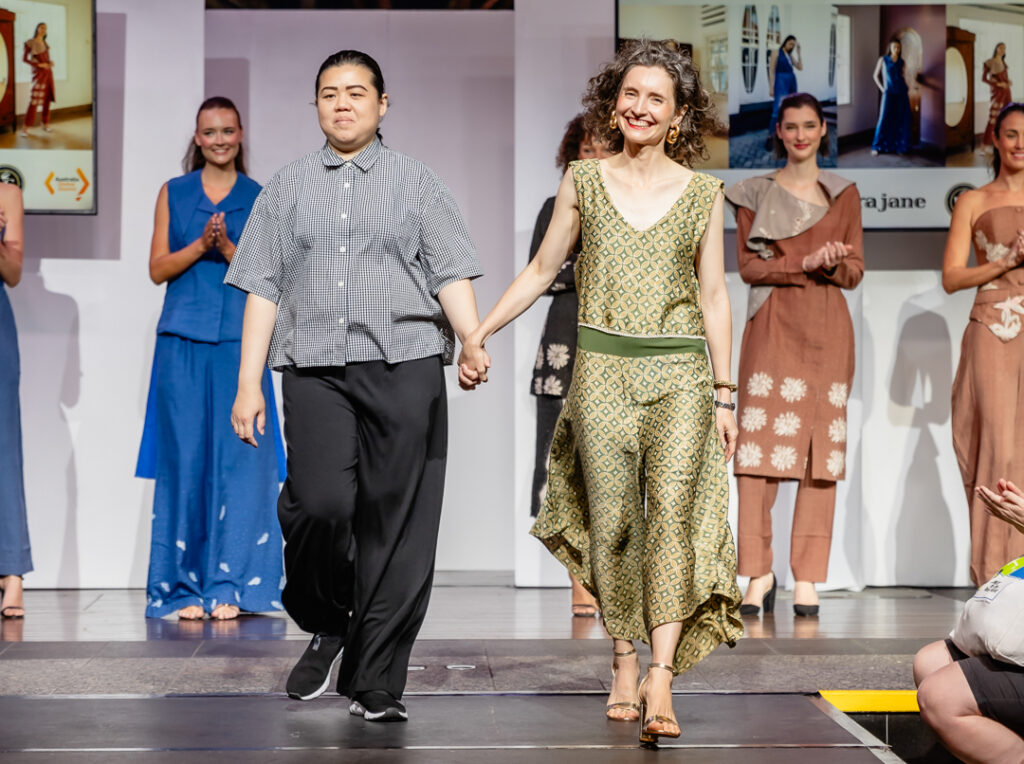
Eri Silk and Batik Fashion Collection with designers Janet Teowarang (centre left) and Carla van Lunn (centre right), 2024, photo Jasmin McCormack
Carla van Lunn heralds the warm browns and calming indigos that Janet Teowarang brings to Queensland.
(A message to the reader.)
My first exposure to the fashion industry was as a wide-eyed child in the 1980s. It was in my home city of Brisbane, watching catwalk shows by local designers in the Queen Street Mall, the heart of the CBD. In this pre-internet world, the work of Brisbane designers was dazzling and sophisticated to my childlike eyes. Lamé, beading, embroidery, fabric-covered shoes and matching hats, statuesque models cutely smiling and twirling for the audience, elegantly removing their shoulder-padded jackets to reveal their matching dresses underneath.
This was a time before the globalisation of fashion production and free-trade imports to Australia, when there was more textile and garment making in the region and more consumer support for local design.
Later on, as a young adult, I studied fashion at university, and after graduation, I was keen to leave Brisbane behind and experience life in a more cosmopolitan place. In a more global and digitally connected world, I sought adventure in European cities with bigger industries, more sartorial heritage, and avant-garde fashion!
Decades later, seasoned in Paris and with a dash of Indonesian spice, I’ve returned full circle to the very same place where I saw fashion as a child, this time as an educator and industry player. In October 2024, as part of Brisbane Fashion Month, I stood on the stage in the same open-air pedestrian mall alongside fellow fashion academic and designer Janet Teowarang from Surabaya, Indonesia, teaching the audience about the craft of batik, peace silk, hand-weaving and natural dyes.
- Janet Teowarang, skirt suit, 2024, Hand-woven Eri silk and Tencel, natural dye, batik, photo Jess at Vethaak Media
- Janet Teowarang, tunic and trouser, 2024, Hand-woven Eri silk and Tencel, natural dye, batik, photo Jess at Vethaak Media
- Janet Teowarang, jacket and trouser, 2024, Hand-woven Eri silk and Tencel, natural dye, batik, photo Jess at Vethaak Media
- Janet Teowarang, jacket and skirt, 2024, Hand-woven Eri silk and Tencel, natural dye, batik, photo Jess at Vethaak Media
- Janet Teowarang, blouse and trouser set, 2024, Hand-woven Eri silk and Tencel, natural dye, batik, photo Jess at Vethaak Media
- Janet Teowarang and Carla van Lunn, Eri Silk and Batik Fashion Collection, 2024, photo Jasmin McCormack
- Carla van Lunn, jumpsuit, 2024, Hand-woven Eri silk and Tencel, natural dye, batik, photo Jess at Vethaak Media
- Carla van Lunn, dress, 2024, Hand-woven Eri silk and Tencel, natural dye, batik, photo Jasmin McCormack
- Carla van Lunn, bustier and trouser, 2024, Hand-woven Eri silk and Tencel, natural dye, batik, photo Jasmin McCormack
The warm spring breeze was blowing in the right direction for the models’ hair and soft garments as Janet and I presented a collection of looks designed by the two of us in collaboration with the Indonesian artisanal textile business, KaIND. I realised it was a proud moment to be showing this hand-crafted collection, capturing both a local and international flavour and providing a live experience for the public audience. It was a return to something slower, more sensory, more community-focused, in contrast to the dizzying world of 24/7 fashion imagery and commentary via Instagram and the like.
The slubby texture of the peace silk and hand-weaving, the earthy soft pigments of the natural dyes, and the hand-drawn batik motifs were an exotic note among the bright and sporty resort wear and super bold prints of Brisbane fashion design. Janet brought sharp tailoring and Indonesian modesty to the collection, while I included some more casual backless and strapless numbers. It was a fusion of Queensland’s coastal-inspired style with the richness and formality of Indonesian fabric.
Since her first Australian visit in 2017, thanks to DFAT’s Australia Awards program, Janet has been motivated by the Australian market’s interest in sustainable fashion. She was also inspired by the rich cultures of Australia’s First Nations and, in particular, batik projects by Aboriginal artists. She has since sought to build bilateral relationships between Indonesia and Australia through fashion and textiles.
Janet works tirelessly as an academic, mentoring a younger generation of designers. She also travels and facilitates industry projects and provides design support to textile artisans in regional villages in East Java, where she is based. We both share a passion for the beauty and ancestral wisdom of Indonesia’s textile crafts and a vision to see more from Australia’s near neighbour on the international stage. Thanks to Janet’s relationship-building, we were able to work with the social enterprise KaIND to produce the fabrics for our collection.
As female designers, Janet and I find common ground in our approach to garment design, which is focused on ease and elegance and honours the hand-work of the artisan producers. Our collaborative collection is about the poetry of the earth, women’s bodies, and the spirit of the fabrics. Janet tells me she loves to watch the hand-loom weaving in the KaIND textile workshop. The gentle rhythmic clacking of the manually operated wooden machines calms her mind and spirit.
The handwoven silk, called Eri Silk, is farmed in the Pasuruan Regency. The cocoons are carefully cut open to save the silk-worms in the yarn-making process, and the silk is spun with TencelTM to provide a smooth and lightweight quality to the fabric. This fibre blend provides coolness and breathability for the hot climate. KaIND’s hand-woven fabrics always feature their signature background motif in the weave, which looks like little geometric flowers.
The colours of the collection come from natural pigments, including flowers, fruits, leaves, bark and roots. Colours included soft, warm browns, clear, calming indigos, and an impressive inky black that showcased the batik with striking contrast. The batik motifs, like the natural colours, reflect the artisans’ natural surroundings. Patterns include orchids, tuberoses and chrysanthemums, volcanic Mount Bromo, and the region’s famous whispering sands.
While I would normally be more hands-on with the patternmaking and sample-making of my designs, for this project Janet asked me to send her my sketches, and then she oversaw the entire sampling and production process. Thanks to an Australia Awards alumni grant, Janet achieved her dream of bringing Pasuruan peace silk and batik to Australia.
Beyond our catwalk presentation, Janet has worked with an Australia-based colleague, Dr Nehemia Sugianto from Southern Cross University, to launch a digital platform connecting Indonesian silk producers with Australian designers.
Thanks to the support of Brisbane Fashion Month director Laura Churchill, we were able to provide a full experience for the audience in The Queen Street Mall, showing videos of the KaIND workshop in action. The documentary footage transported viewers to the light-filled bamboo buildings and tranquil tropical gardens of the Pasuruan workshop. It was eye-opening for the audience to see the silk-making and hand-weaving process, and for many, it was their very first exposure to the craft of Indonesian batik. With Brisbane’s sub-tropical climate and thirst for colour and pattern, this show felt like part of a new era of conscious and fresh fashion in the region. Perhaps something to inspire a younger generation on their path into the fashion industry.
About Carla van Lunn
 Carla van Lunn is a fashion creative based in Brisbane, also known as Meanjin to the Traditional Owners of the Land. From 2016 to 2018, she led DFAT’s Australia Awards in Indonesia short course, “International Business Readiness – for the Fashion and Textiles Sector”. She teaches at the Queensland University of Technology and continues to foster fashion connections between the two countries.
Carla van Lunn is a fashion creative based in Brisbane, also known as Meanjin to the Traditional Owners of the Land. From 2016 to 2018, she led DFAT’s Australia Awards in Indonesia short course, “International Business Readiness – for the Fashion and Textiles Sector”. She teaches at the Queensland University of Technology and continues to foster fashion connections between the two countries.
About Janet Teowarang
 Janet Teowarang is the founder and creative director of her own fashion brand, Allegra Jane. She is also a fashion lecturer at Universitas Ciputra Surabaya. Janet is the Australia Awards Alumni for Short Term Awards of Fashion and Textile sector and Alumni Grant recipient in 2019, 2021 and 2024. She loves the history of fashion, world art and crafts, and is very excited to visit every museum when she travels around the world.
Janet Teowarang is the founder and creative director of her own fashion brand, Allegra Jane. She is also a fashion lecturer at Universitas Ciputra Surabaya. Janet is the Australia Awards Alumni for Short Term Awards of Fashion and Textile sector and Alumni Grant recipient in 2019, 2021 and 2024. She loves the history of fashion, world art and crafts, and is very excited to visit every museum when she travels around the world.












